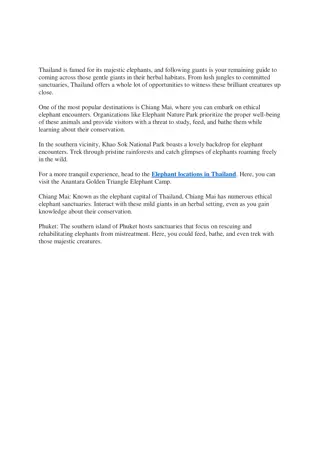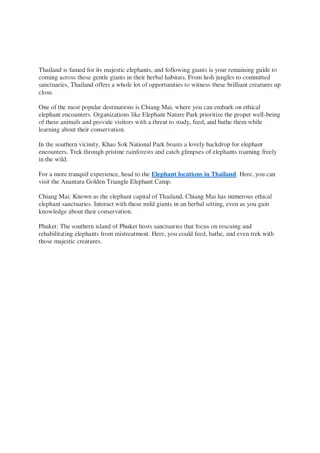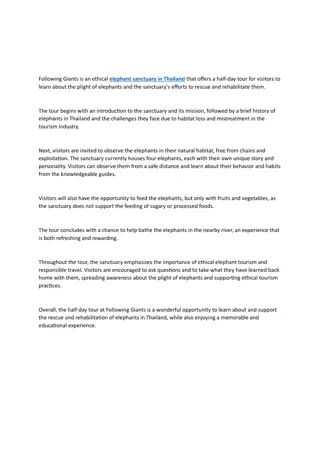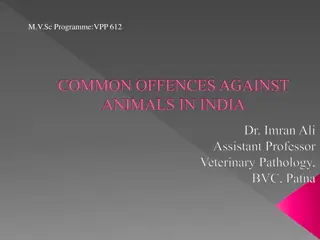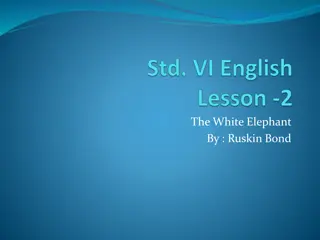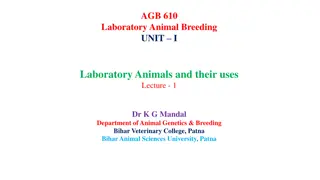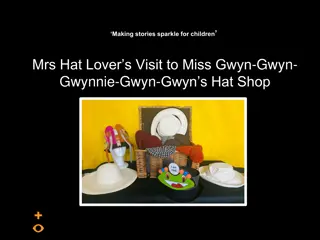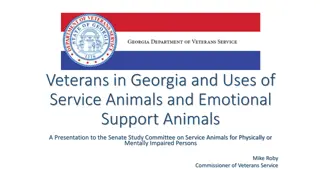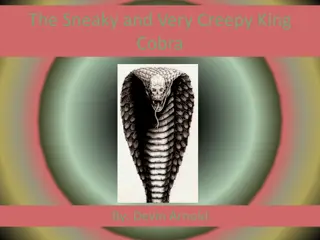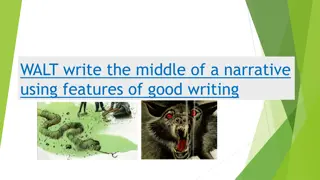Spotting Animals: Hat, Elephant, Snake!
In a playful scene, various creatures are imagined - a hat, an elephant, and a snake. Delve deeper into creativity and imagination in this intriguing portrayal of diverse elements that spark curiosity and wonder. Explore the fantasy world and unlock the imagination with this whimsical observation.
Download Presentation

Please find below an Image/Link to download the presentation.
The content on the website is provided AS IS for your information and personal use only. It may not be sold, licensed, or shared on other websites without obtaining consent from the author.If you encounter any issues during the download, it is possible that the publisher has removed the file from their server.
You are allowed to download the files provided on this website for personal or commercial use, subject to the condition that they are used lawfully. All files are the property of their respective owners.
The content on the website is provided AS IS for your information and personal use only. It may not be sold, licensed, or shared on other websites without obtaining consent from the author.
E N D
Presentation Transcript
What do you see? A hat? An elephant? A snake? An elephant and a snake?
If you have seen this image before .
How about out in the World? In Real Life. What do we see? What is it that we perceive?
The Conventional view of perception
A primary goal of perception is to recover, or estimate, objective properties of the physical world. A primary goal of perceptual categorization is to recover, or estimate, the objective statistical structure of the physical world.
Which object is casting the shadow?
Bayes Circle We can only see the world through our posteriors. When we measure priors and likelihoods in the world, our measurements are necessarily altered through our posteriors. Using our measurements of priors and likelihoods to justify our posteriors thus leads to a vicious circle.
Bayes Circle This essentially means that in order to know or perceive the world, we must have a prior knowledge or perception of it to compare to.
Shiny check Dimpled check Yellow brown check Desirable female ? It must be .. Oh no, not really
The Interface Theory of Perception The perceptions of an organism are a user interface between that organism and the objective world
Do I really want or need to know all this?
Where is my file???? An interface is helpful!
Conventional Theory Reconstruction Thesis Perception reconstructs certain properties and categories of the objective world (Hoffman). In essence, what you see is what you literally get. There are infinitely many and infinitely complex possibilities in the objective reality.
Interface Theory Construction Thesis Perception constructs the properties and categories of an organism s perceptual world (Hoffman). In a sense, we perceive only the necessary qualities of the objective reality. Our perceptual systems instead display relevant representations of more complex phenomena in a simpler form, much like icons on a computer.
Interface Theory of Perception predicts that Each species has its own interface Almost surely, no interface performs reconstruction Each interface is tailored to guide adaptive behavior in a relevant niche Much of the competition between and within species exploits the strength and limitations of interfaces Such competition can lead to arms races between interfaces and critically influence their adaptive evolution.
Reconstruction? Model? Need for Isomorphism? Perception is indeed qualitatively different from the represented physical reality: here Hoffman is right Perception is not a reconstruction but it is a representation Is Hoffman correct in maintaining that perception doesn t even need an isomorphism with reality? 2D retinotopic neural maps as an example of isomorphism Given isomorphism, can we think of perception as a model of reality, hence constructed if not reconstructed?
References D. Hoffman. The interface theory of perception: Natural selection drives true perception to swift extinction.In Object categorization: Computer and human vision perspectives, S. Dickinson, M. Tarr, A. Leonardis, B. Schiele (Eds.) Cambridge, UK: Cambridge University Press, 2009, 148 165. J.P. Frisby and J.V. Stone Seeing The Computational Approach to Biological Vision, 2nd Edition, The MIT Press 2010


